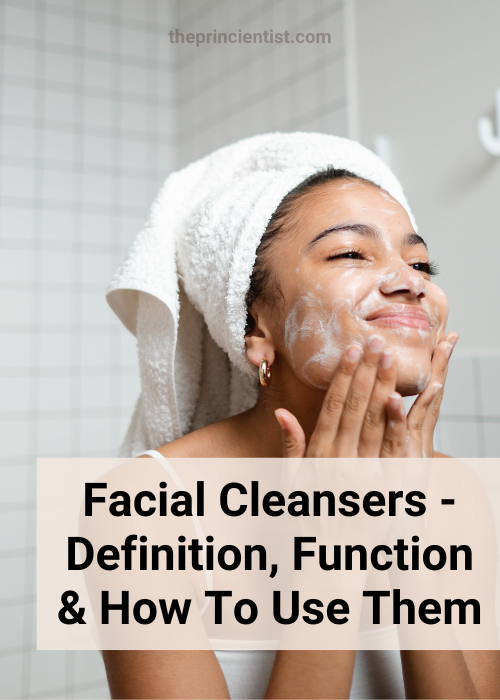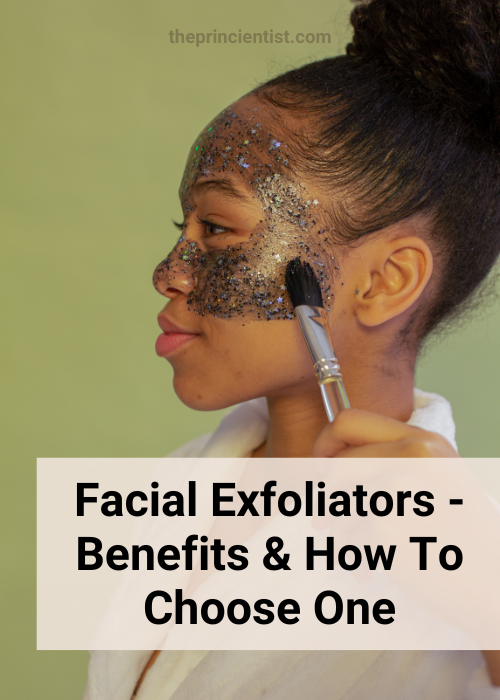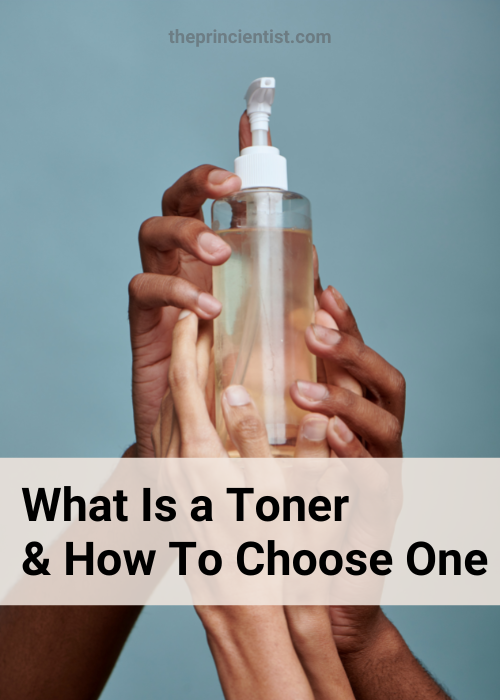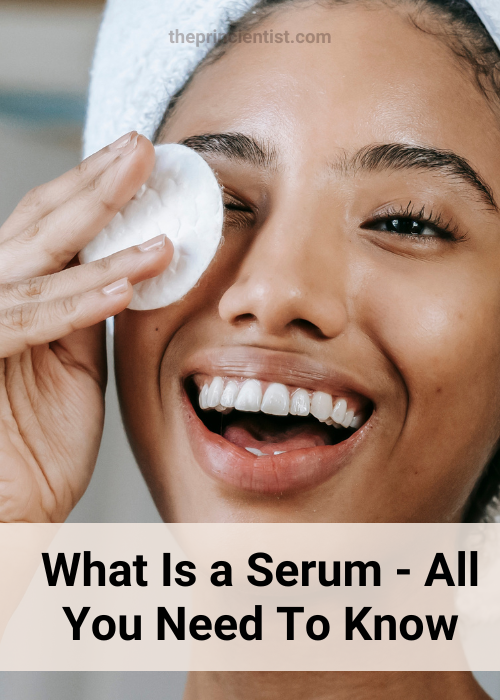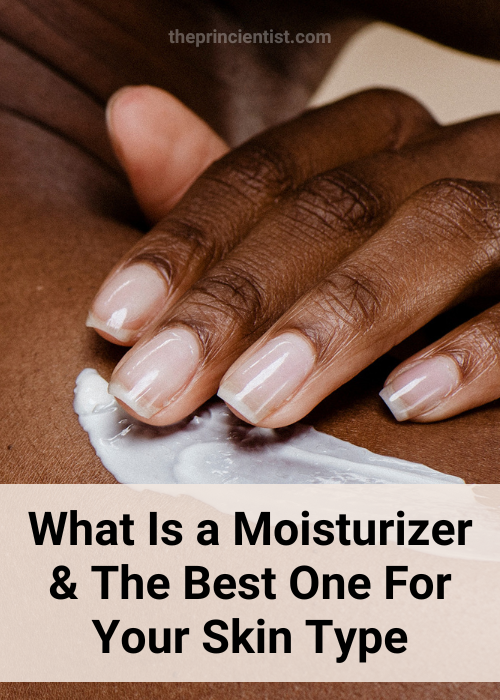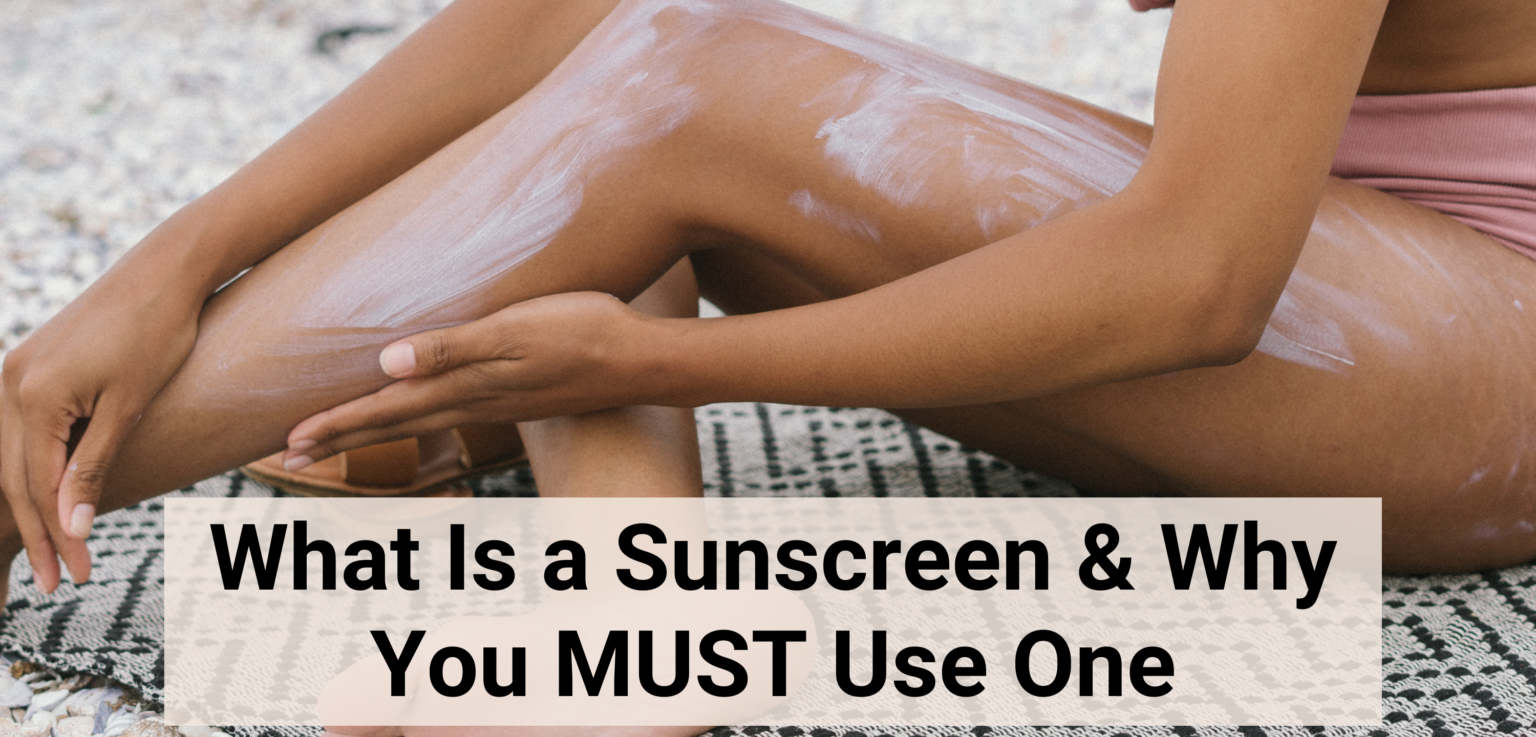
The Most Important Step in Your Skincare Routine
You will learn what is sunscreen, what types of sunscreens exist and how to use them to keep your skin healthy.
This post is a complete guide to sunscreens.
Table of Contents:
- What is sunscreen?
- Why use sunscreen?
- What is the function of a sunscreen?
- How does sunscreen work?
- SPF Levels explained
- Why do you need to reapply sunscreen?
- Who needs sunscreen?
- Do black people need sunscreen?
- Is sunscreen needed inside the house?
- What types of sunscreen exist?
- Which type of sunscreen is better?
- Other forms of sun protection
- Learn how to apply sunscreen. Step-by-step Instructions.
- Sunscreen in your skincare routine
You can find all references used to write this post here.
What is sunscreen?
Sunscreen is a substance that protects the skin from the harmful effects of solar UV radiation.
Why use sunscreen?
You should use sunscreen to keep your skin healthy.
UV radiation from the sun damages the skin and can lead to sunburns or worse, skin cancer.
Psychological health is also affected when your confidence decreases with premature aging and dark spots.
Sunscreens block ultraviolet radiation and prevent many skin issues.
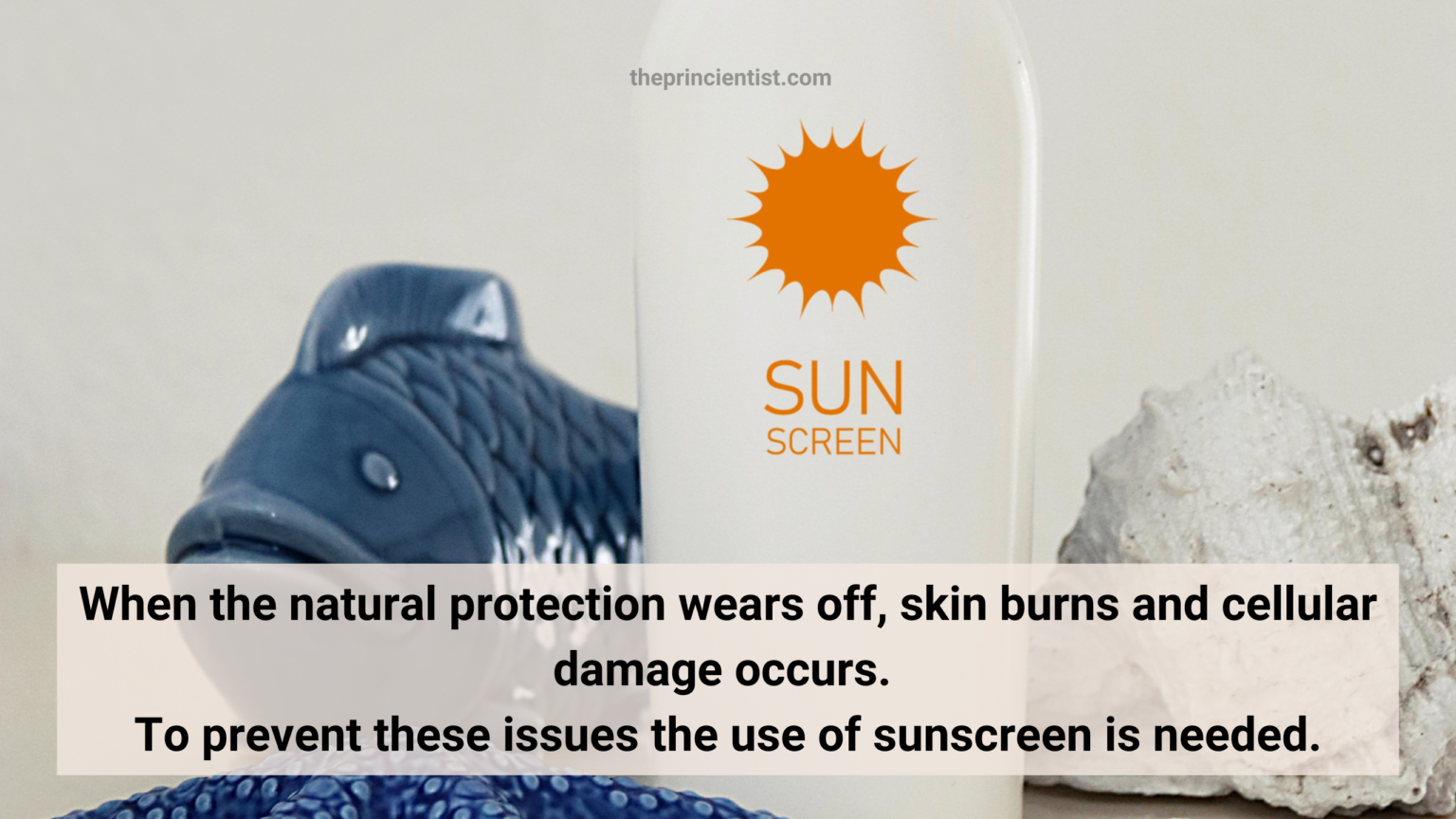
What is the function of sunscreen?
The main role of sunscreen is to block the sun’s UV rays from entering the skin and causing damage.
The skin has its natural protection from the sun – melanin.
Melanin is the pigment that is responsible for skin colour. It also protects us against the harmful effects of UV rays.
The more melanin you have more natural protection against the sun’s damaging effects.
This is why individuals with black skin (skin that produces more melanin) are favoured with being less likely to suffer from sunburns and enjoy bigger natural protection.
When the natural protection wears off, skin burns and cellular damage occurs. To prevent these issues the use of sunscreen is needed.
By applying sunscreen, you can prevent the skin from damage such as sunburn, and hyperpigmentation.
Sunburn Prevention:
Sunburns are caused by UV rays. And despite what many of us think, even black skin can burn.
Sunscreen creates a protective film on the skin that blocks UV radiation and prevents injuries to the skin cells avoiding burns.
Hyperpigmentation Improvement:
Hyperpigmentation is caused by excessive production of melanin that shows as uneven skin tone.
Melanin is reactive, meaning that its amount of production can be increased or decreased by many external factors including unprotected exposure to sunlight.
When stimulated by sun rays, our cells produce more melanin, triggering hyperpigmentation or darkening of the skin in uneven patches.
If you already have dark marks on your face or body, the discolouration may become more noticeable.
Sunscreen prevents the sun from producing excess melanin protecting your skin from further discolouration.
This also speeds up the fading of darker areas that are no longer getting darker.
Premature Aging Prevention:
Sunscreen prevents premature skin aging.
About 80% of facial aging is attributed to sun exposure.
Skin’s elastin and collagen, the two major components which maintain the skin’s flexibility and strength get damaged by exposure to UVA rays.
Failure to protect from the harmful effects of UVA radiation contributes to premature aging and consequential loss of the skin’s young look.
Sunscreens protect against the photodamage caused by the sun, including wrinkles, sagging and age spots.
Although black women are less susceptible to the signs of aging (wrinkles, sunspots), we still age with at least some wrinkles.
Decreases the Risk of Skin Cancer:
Sunscreen also decreases the risk of skin cancer.
About 90 % of cases of skin cancer are associated with exposure to the sun’s harmful UV rays.
There is a direct correlation between sun exposure and skin cancer, even in people with black skin.
Different clinical studies have shown that regular use of sunscreens can promote skin cancer reduction, especially melanoma and squamous cell carcinoma.
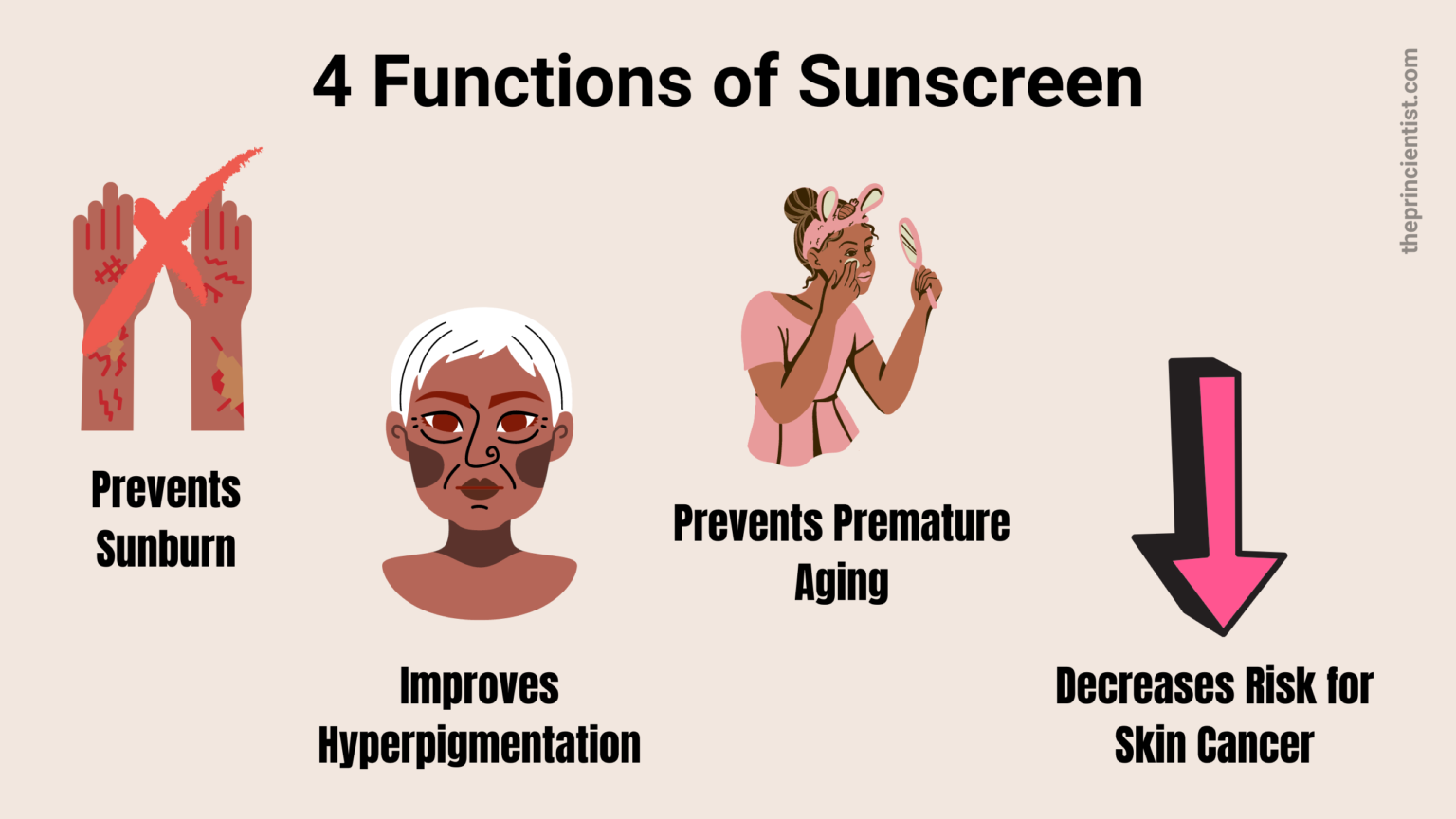
Other than protection, sunscreen products can be specially formulated with beneficial ingredients to provide other benefits for your skin.
See the “how to choose a sunscreen” section for more information on active ingredients.
How does sunscreen work?
The sun releases energy that reaches the earth in the form of visible light (ex: sunlight), infrared (the warmth from the sun), and ultraviolet (UV) rays.
3 types of UV rays exist – Ultraviolet A (UVA), Ultraviolet B (UVB), and Ultraviolet C (UVC).
UVC rays are absorbed by the ozone layer, so you are only exposed to UVA and UVB rays.
Overexposure to UVA rays contributes to premature skin aging and skin cancer, while UVB causes sunburn and skin cancer.
This makes it important to use sunscreen that protects against both UV radiations.
Sunscreens work in 2 ways – reflect or absorb both ultraviolet A and B radiation.
Reflection of UV rays:
Reflect (including scattering): sunscreen’s inorganic chemicals create a barrier that reflects UV rays from the skin’s surface like a shield.
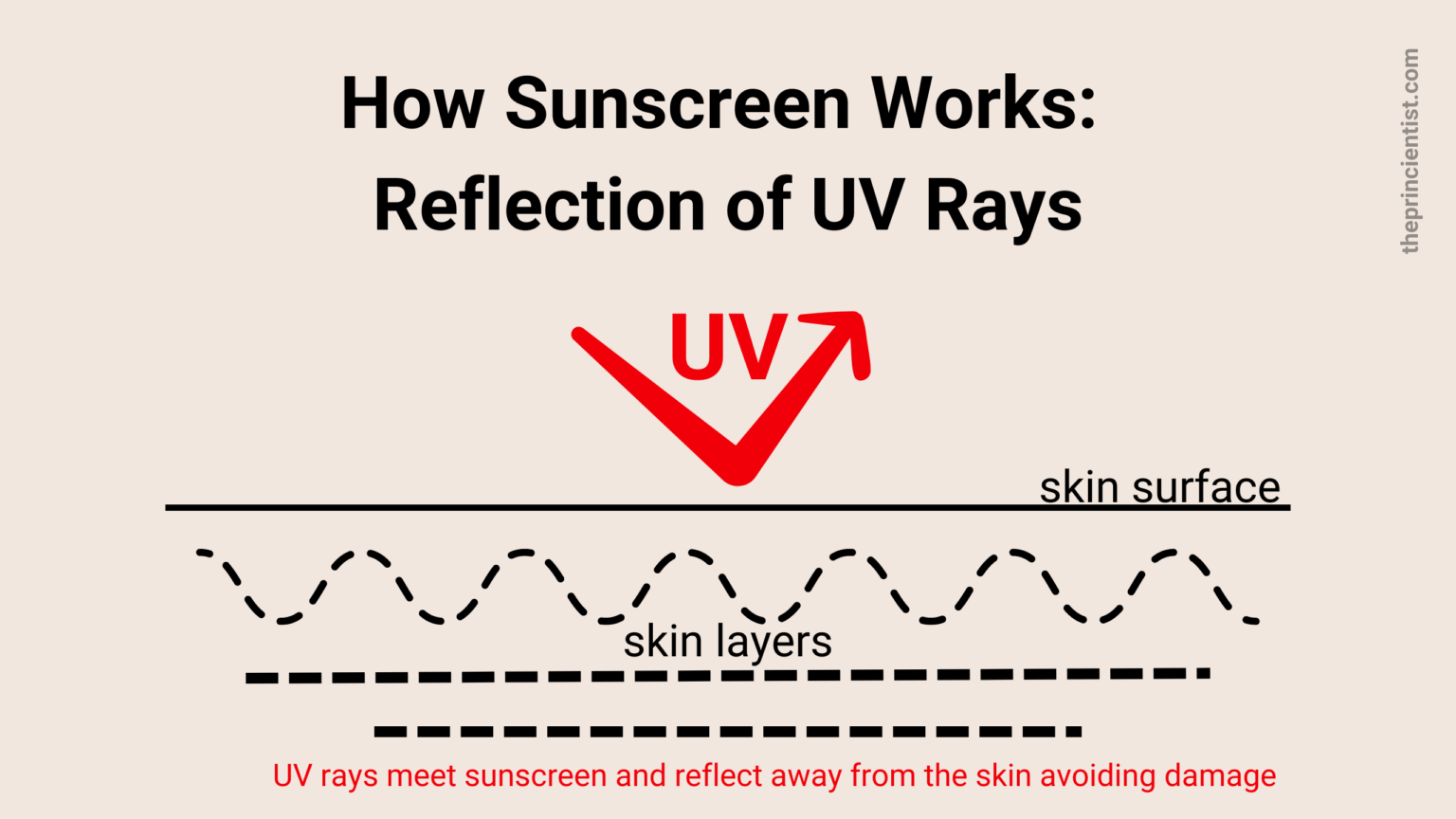
Absorption of UV rays:
Sunscreen’s chemical components sink into the top layers of the skin.
Their chemical bonds absorb the UV rays before they can damage your skin cells. As the bonds absorb UV radiation, the components of the sunscreen slowly break down and release heat.
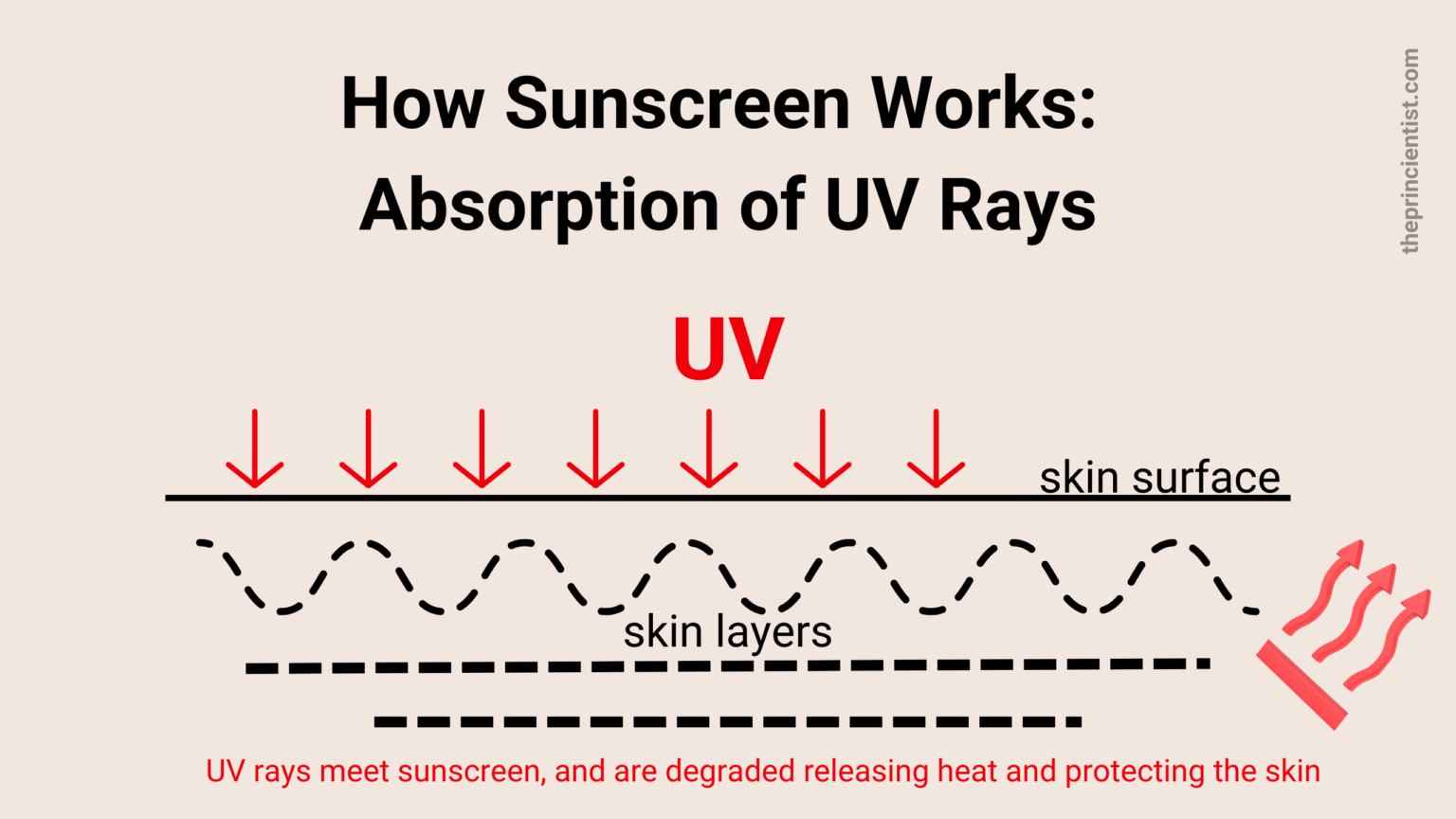
Most sunscreens combine both organic and inorganic active ingredients to simultaneously absorb and reflect UV rays protecting the skin.
What is SPF?
SPF stands for sun protection factor.
The number beside it indicates how effectively a sunscreen protects the skin against UVB rays that are responsible for sunburns and skin cancer.
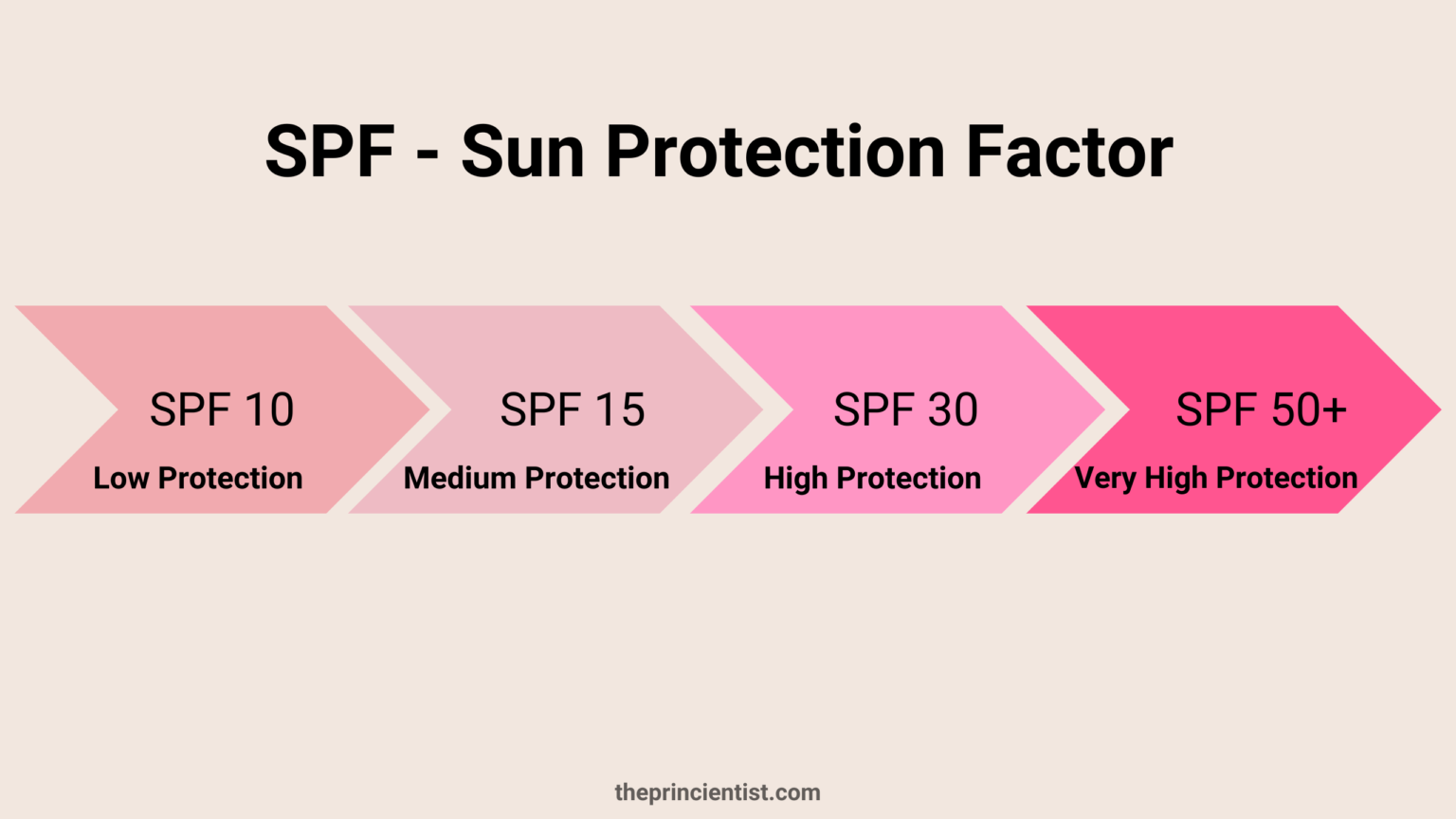
Sunscreen needs to be labelled as broad spectrum to protect against both UVB and UVA rays. And the UVA protection needs to account for at least 1/3 of the UVB protection.
You need to look for a broad-spectrum designation on the container.
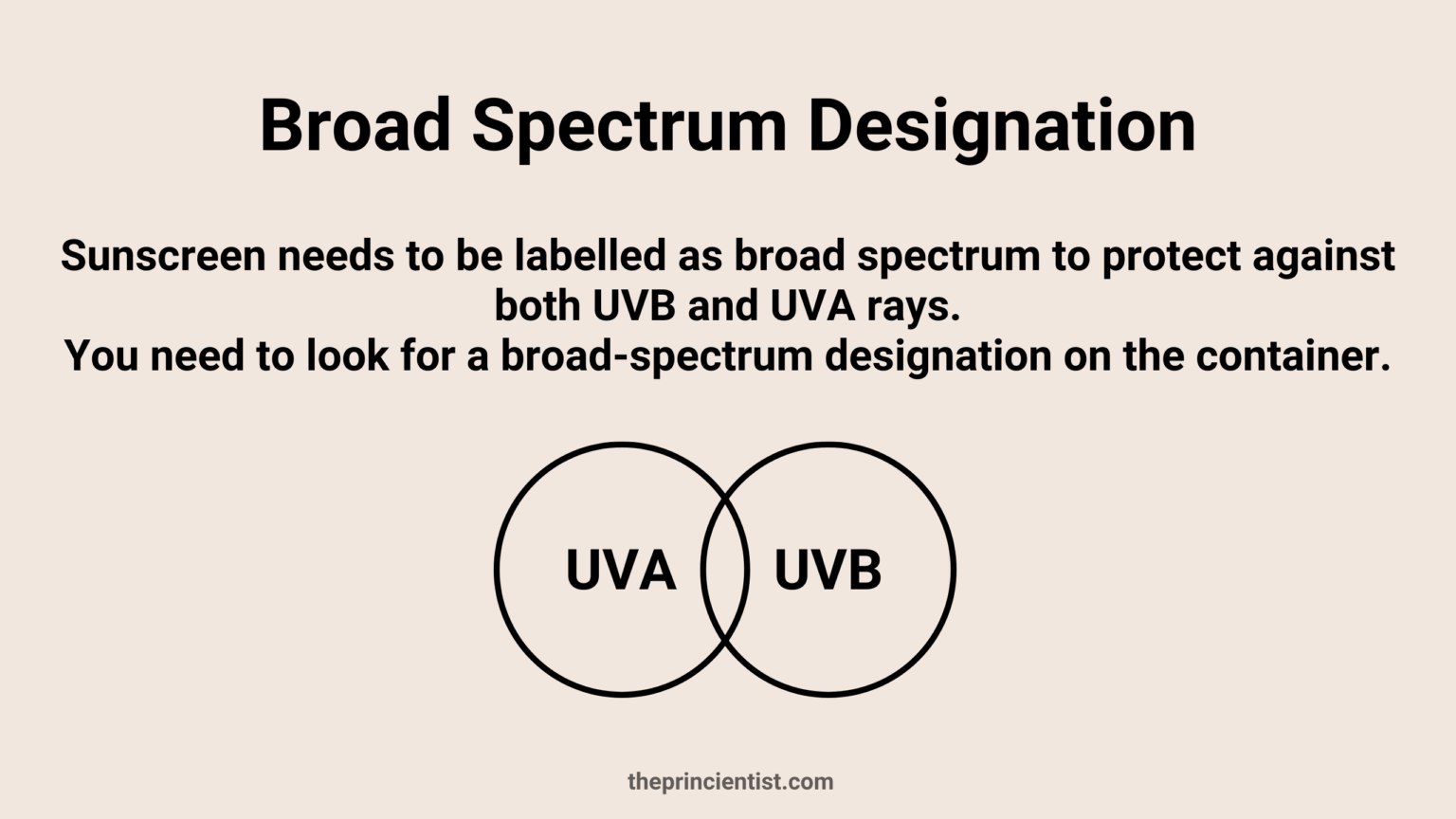
Why do you need to reapply sunscreen?
The reason you need to reapply sunscreen is that sunscreens become ineffective over time while protecting the skin against UV rays.
Sunscreen creates a thin protective film over your skin.
Rather than fading, it is consumed. Sunscreen transforms harmful UV rays into heat disappearing in the process.
The more UV rays they absorb, the faster their degradation. That’s why it must be reapplied.
For example, the sun is stronger in the middle of the day compared to early morning and at the end of the day.
That means the risk of sunburn is higher between midday and afternoon. You need to reapply sunscreen more often during those times than during early morning or at the end of the day.
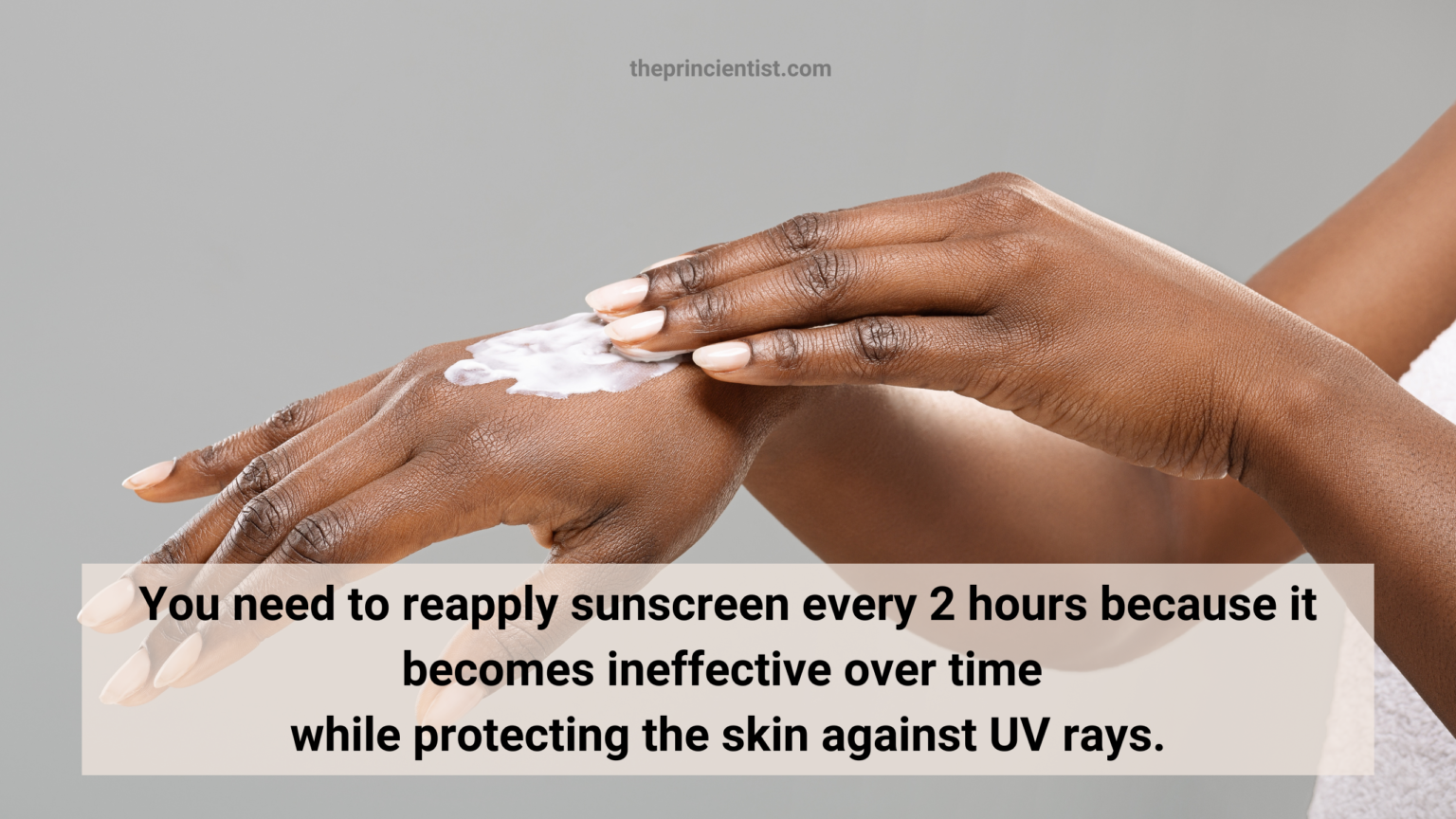
Who needs sunscreen?
Everyone!
The World Health Organisation and the American Academy of Dermatology recommend that men, women, and children over 6 months of age should use sunscreen every day.
Do black people need sunscreen?
I said, everyone.
Black people have a natural SPF of 13 which means we can stay in the sun without burning thirteen times longer than a white person.
However, we still need to include sunscreen in our daily skin-care program for four key reasons:
– black skin is not immune to sunburns that damage the skin. It can and will burn. Also, the skin will be damaged by sun exposure over your lifetime, whether or not you burn.
– to ward off the aging effects from the sun
– avoid worsening hyperpigmentation.
– to be healthier. Sun suppresses the immune system diminishing the body’s ability to fight against infections, cancer, and other diseases. Although there is a low risk of skin cancer, it is still a possibility.
Black people need to spend more time in the sun to get enough vitamin D so make sure you are protected.
Melanin protects but it’s not a miracle maker. Protect yourself. Use sunscreen.
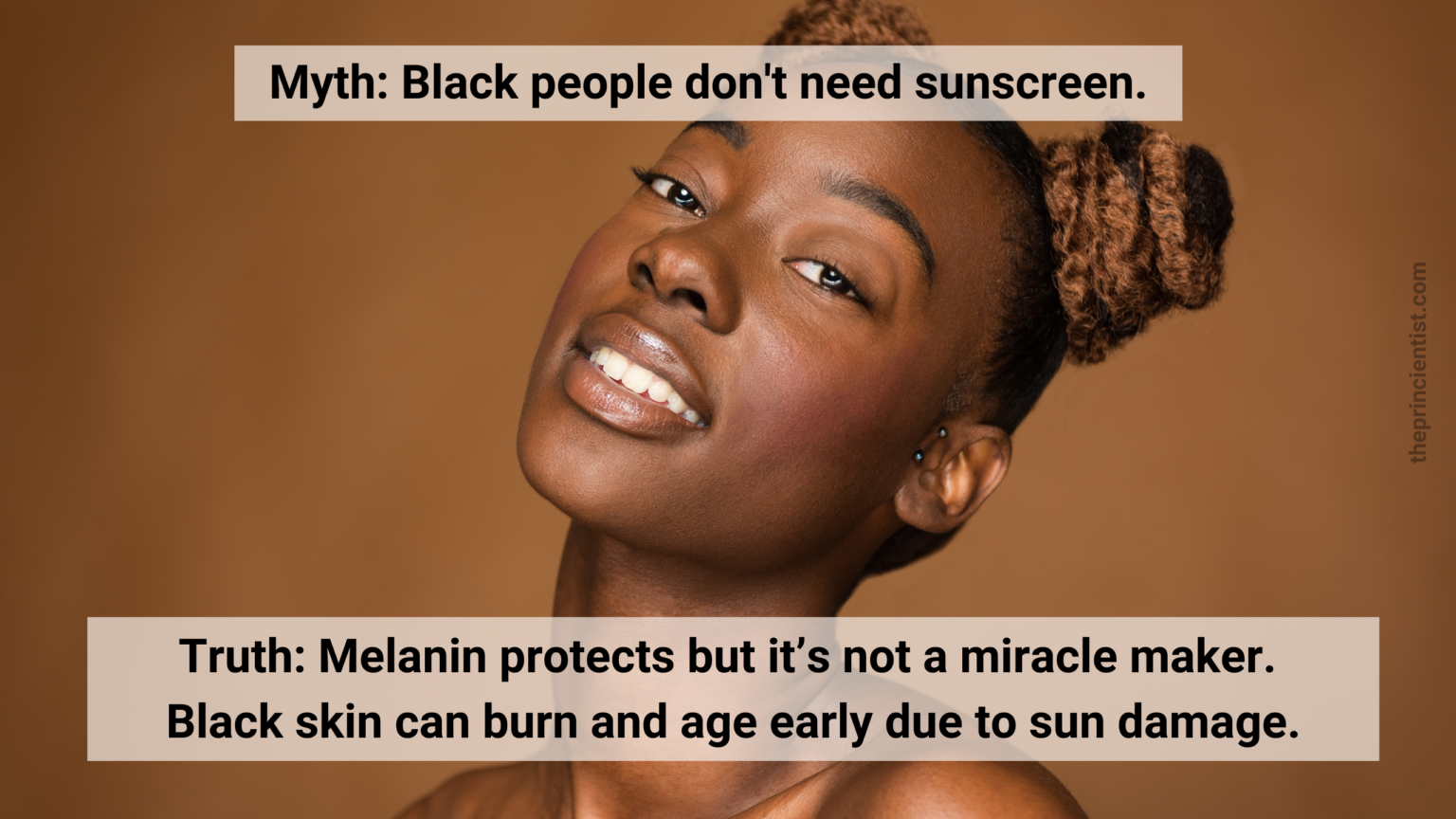
Is sunscreen needed inside the house?
Yes.
Indoors you are rarely exposed to sunlight, but if you are by a window that is directly hit by sunlight use sunscreen.
As mentioned, you are exposed to 2 types of UV rays – UVA and UVB.
UVB is typically blocked by window glass, while very few types of glass can block UVA completely.
Considering about 80% of UVA light can penetrate windows glass to damage your skin, even on cloudy days and when the temperature is low, most dermatologists recommend the use of sunscreen every day, even indoors.
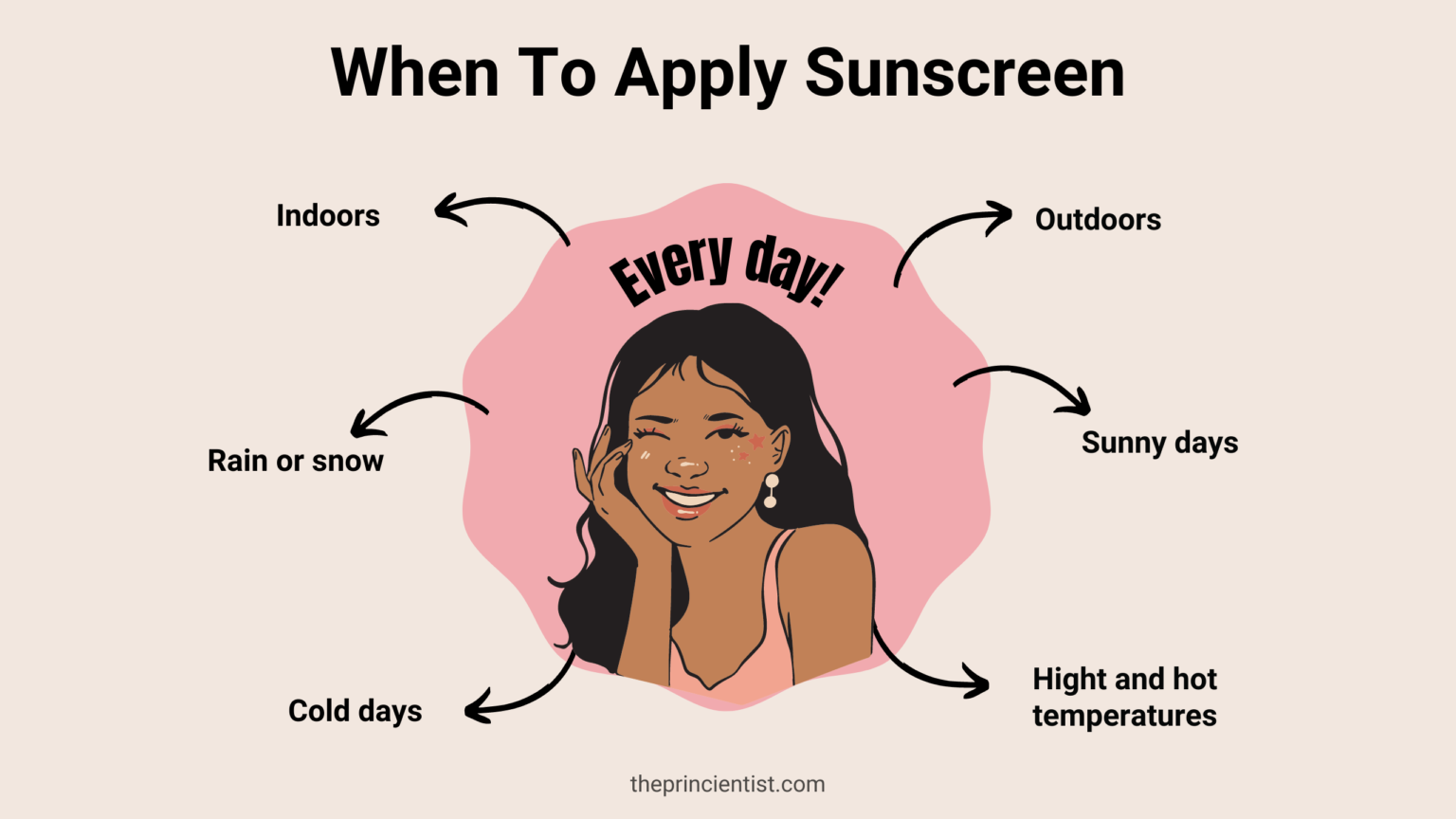
What types of sunscreen exist?
There are 2 types of sunscreens – chemical and physical, that differ in how they work.
Physical/mineral sunscreen:
Physical sunscreen uses inorganic chemicals like zinc oxide or titanium dioxide that are ground into fine particles that leave a noticeable white cast on the skin.
They sit on the surface of the skin and reflect or scatter UV rays away from your skin. Some of these micro-sized particulates, also function in part by absorption.
Chemical sunscreen:
chemical sunscreens use organic chemicals like avobenzone, octisalate, octocrylene and homosalate to absorb UV rays and transform that energy into heat.
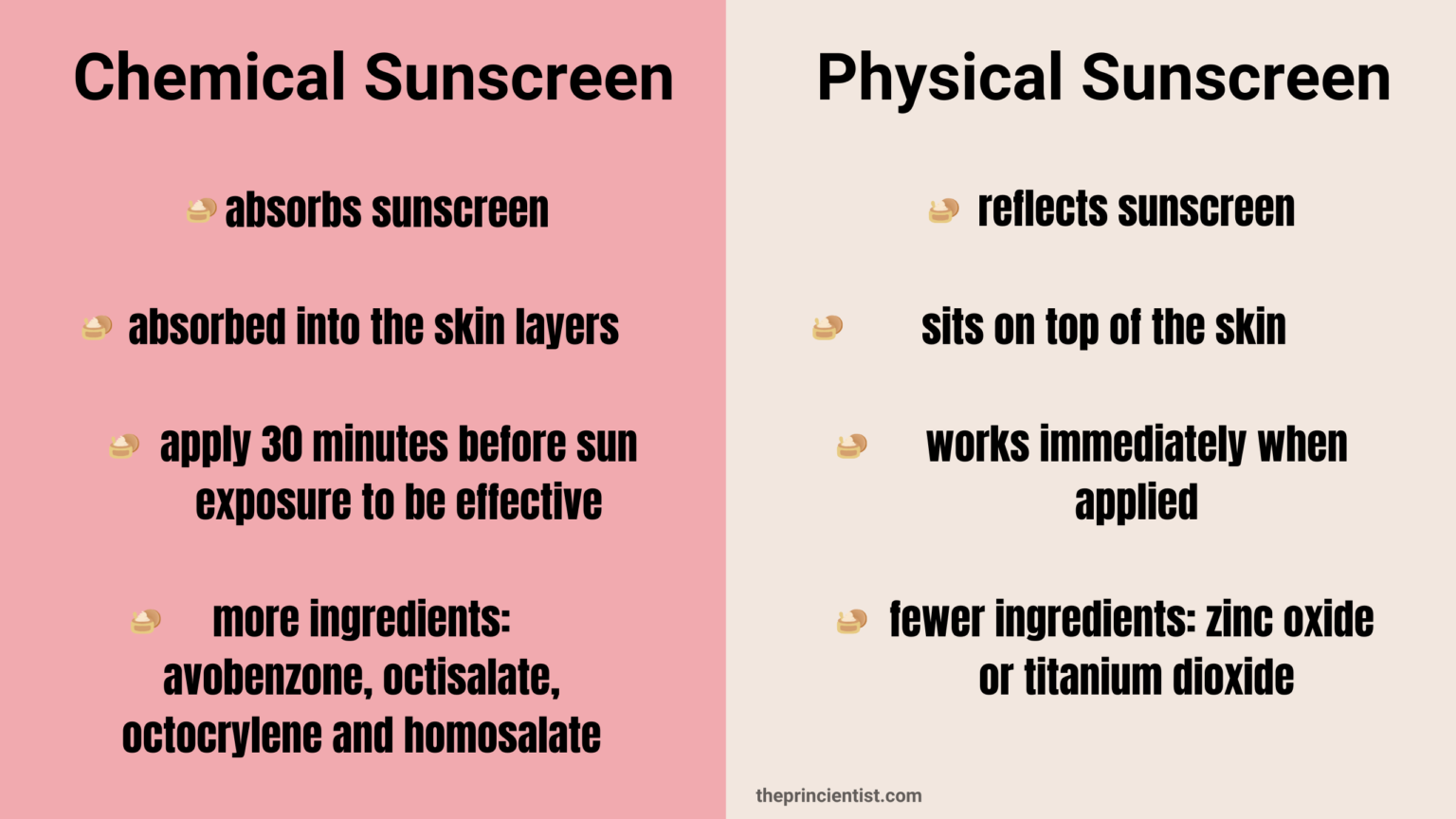
To know which type is the one you are using, read the label and if you see zinc oxide or titanium dioxide, it’s a physical sunscreen. If it lists other active ingredients, it’s a chemical sunscreen.
Sunscreen also comes in many forms, including gels, sticks, powders, sprays, lotions, creams, oils and butter.
Each with it’s own advantages with some being more effective than others. Read the post to make the best choice for your skin.
Which type of sunscreen is better?
Both chemical and physical sunscreens are effective at protecting the skin.
Many sunscreens available for purchase are a combination of both physical and chemical to protect against UVB and UVA rays.
For sensitive skin, chemical sunscreens can have a reaction and a physical sunscreen might be a better choice.
But, on the other hand, physical sunscreens can leave a white cast and can be quite oily.
As for the vehicle of application, lotions and creams have proven to be the most effective and easy to use.
At the end of the day, pick the sunscreen you will use. Otherwise, it’s a personal choice.
Related: Makeup with SPF – Is it effective?
How often should you use sunscreen?
Use sunscreen every day and apply it to your exposed skin at least 30 minutes before going outdoors to allow the sunscreen to absorb into your skin.
Even when it is cloudy when it rains or snows.
Regardless of the SPF, sunscreen should be reapplied every 2 hours after the first application.
Also reapply after swimming, sweating, or washing your face.
Always read the label and follow the manufacturer’s specific instructions for application.
General Guidelines (to maximize your protection):
– Expiration date: Respect the expiration date on the packaging. If a sunscreen does not have an expiration date toss it after one year. After that time there is no guarantee that they remain safe and effective.
– Storage: Leave the sunscreen container away from heat and direct sunlight. Sun exposure reduces sunscreen’s effectiveness and can spoil it before the expiration date. Wrap the container in a towel or in the shade. You can also use coolers.
– Application: The correct amount is two fingers for your face, and a shot glass full for your body. Shake it before applying it.
– Environmental Note: Sunscreens can be pollutants to the ocean’s coral reefs. Do your research and make educated choices.
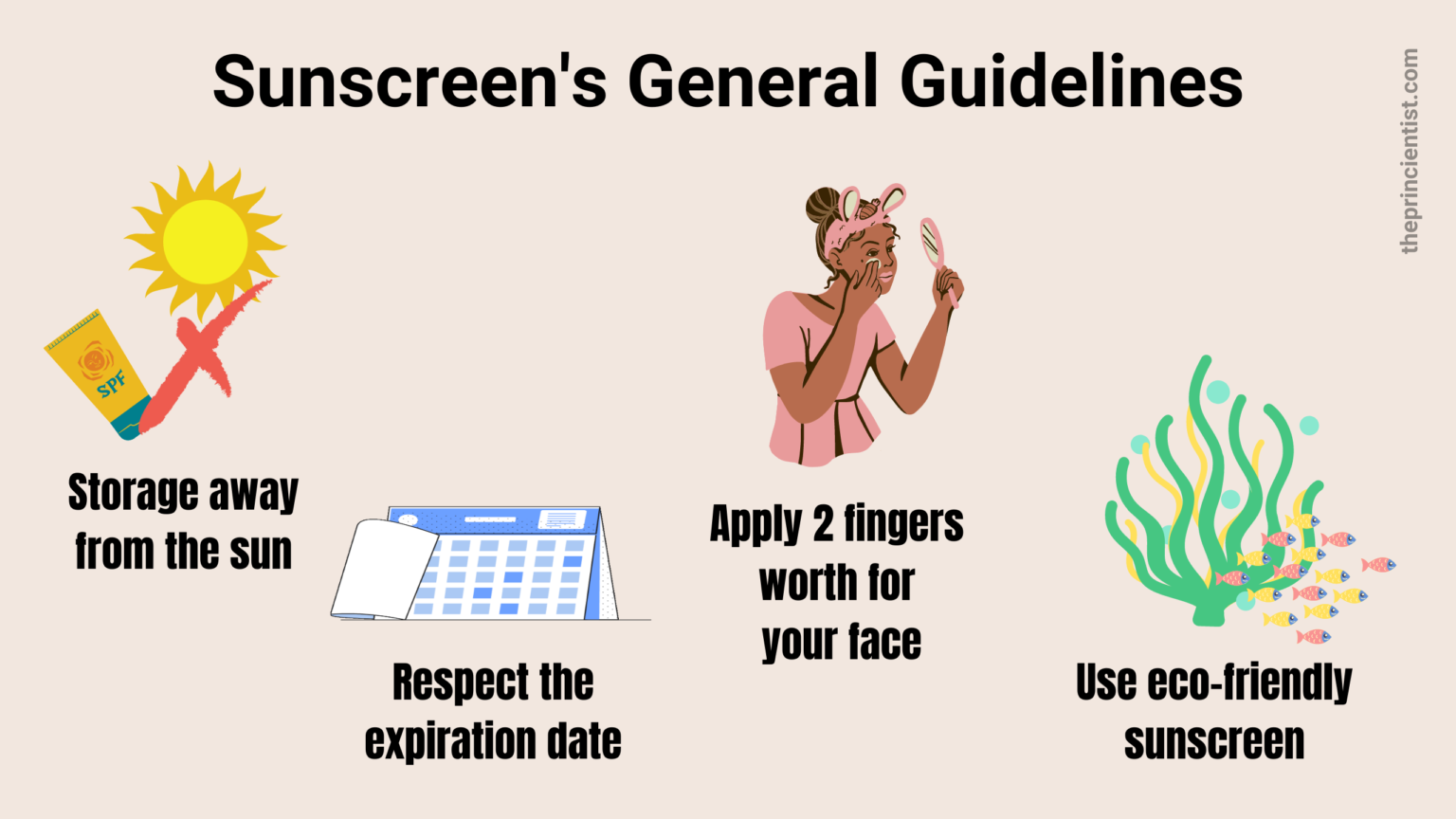
Other forms of sun protection
Sunscreen cannot block all UV rays, so don’t depend just on using sunscreen for protection from sun damage.
There are other forms of sun protection you can adopt to make sure you are safe. These are especially important during summer.
- Sunscreen should be broad-spectrum, water-resistant, with an SPF of at least 30.
- Wear a lip balm with at least SPF 15. I burned my lips last summer and it was not fun.
- Seek the shade when the sun’s rays are strongest. Usually between 11h and 15h
- Wear a wide-brimmed hat that covers your face. It protects and it’s stylish.
- Choose sunglasses that provide UV protection. Check the labels to make sure.
- Wear protective clothing such as a long-sleeved shirt, and pants. During the summer I cover my arms or legs with a light scarf.
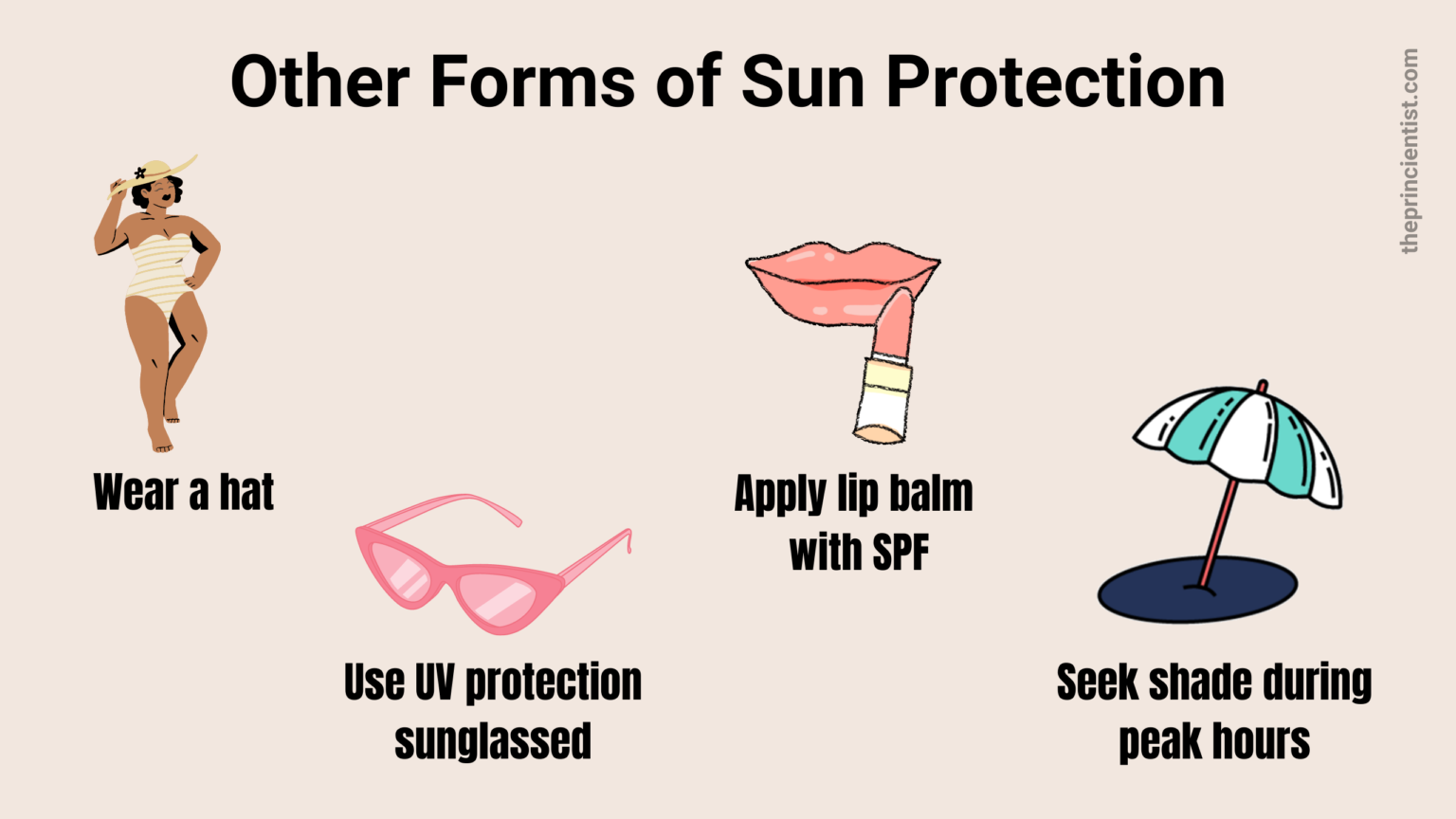
How to choose the right sunscreen?
Both chemical and physical sunscreen provide sun protection. The American Academy of Dermatology (AAD) doesn’t advise using one over the other.
Simply make sure you choose a sunscreen that is broad-spectrum, water-resistant with an SPF of at least 30.
The form of application (lotions, creams, gels, oils) or brand you use is your choice and depends on many factors.
Also, take into consideration your skin type.
Oily skin:
Choose a lightweight sunscreen that will be absorbed into the skin fast with small amounts of oil. Gel or lotions are water-based options that do just that.
Avoid sunscreen butter and heavy creams that contain high amounts of oil and leave the skin greasy.
Make sure it has a matte finish and that the label says it is non-comedogenic. That means it won’t clog pores.
Oily skin produces excess oil, many times to compensate for the lack of water present so find hydrating ingredients like hyaluronic acid, green tea and aloe vera.
Search for ingredients that help control excess sebum production like niacinamide and ceramides.
Although chemical sunscreens are a good option, physical sunscreen formulas contain zinc and titanium which are natural ingredients that do not trigger breakouts.
For black women, do a patch test by applying the physical sunscreens on the skin to guarantee it does not leave a white cast.
Dry skin:
Dry skin lacks sebum which is the skin’s natural oil. Because of this, the skin loses water easily.
Your sunscreen needs ingredients that both hydrate (provide water) and moisturize (provide oil).
Look for hydrating ingredients like squalene, aloe vera, hyaluronic acid and glycerine to compensate for water that is lost naturally.
Moisturizing ingredients like shea butter, vegetable oils like jojoba or grapeseed oil and ceramides will fortify and repair your skin’s barrier.
Avoid sunscreen gels that fade quite fast and contain zero oils. Gel and other clear sunscreens will not help retain water in the skin.
Oil-based creams and lotions are more suitable for dry skin types. During winters use sunscreen butter.
Dry skin is prone to irritation due to the damaged skin barrier. Formulas without alcohol or scent and soothing ingredients like oatmeal and cucumber soothe and improve irritated skin.
Normal skin:
Normal skin produces neither too much nor lacks sebum.
Focus on maintaining the oil balance on the skin.
Hydrating ingredients are beneficial and antioxidant agents like vitamins E and C protect the skin against environmental aggressors.
Use lotions and gels during summer when the skin tends to be oilier and heavier creams during winter months that are harsher on the skin.
Combination skin:
Combination skin is a mix of both oily and dry skin types.
Some areas of the skin are dry and some areas (the T-zone: chin, nose and forehead) are oily.
Look for sunscreens that are hydrating, but not greasy.
Lightweight sunscreen lotions that are non-comedogenic (check the label) are good options.
Avoid pore-clogging ingredients like shea butter, cocoa butter, and coconut oil.
Alternatively, dermatologist-formulated sunscreens exist for this skin type.
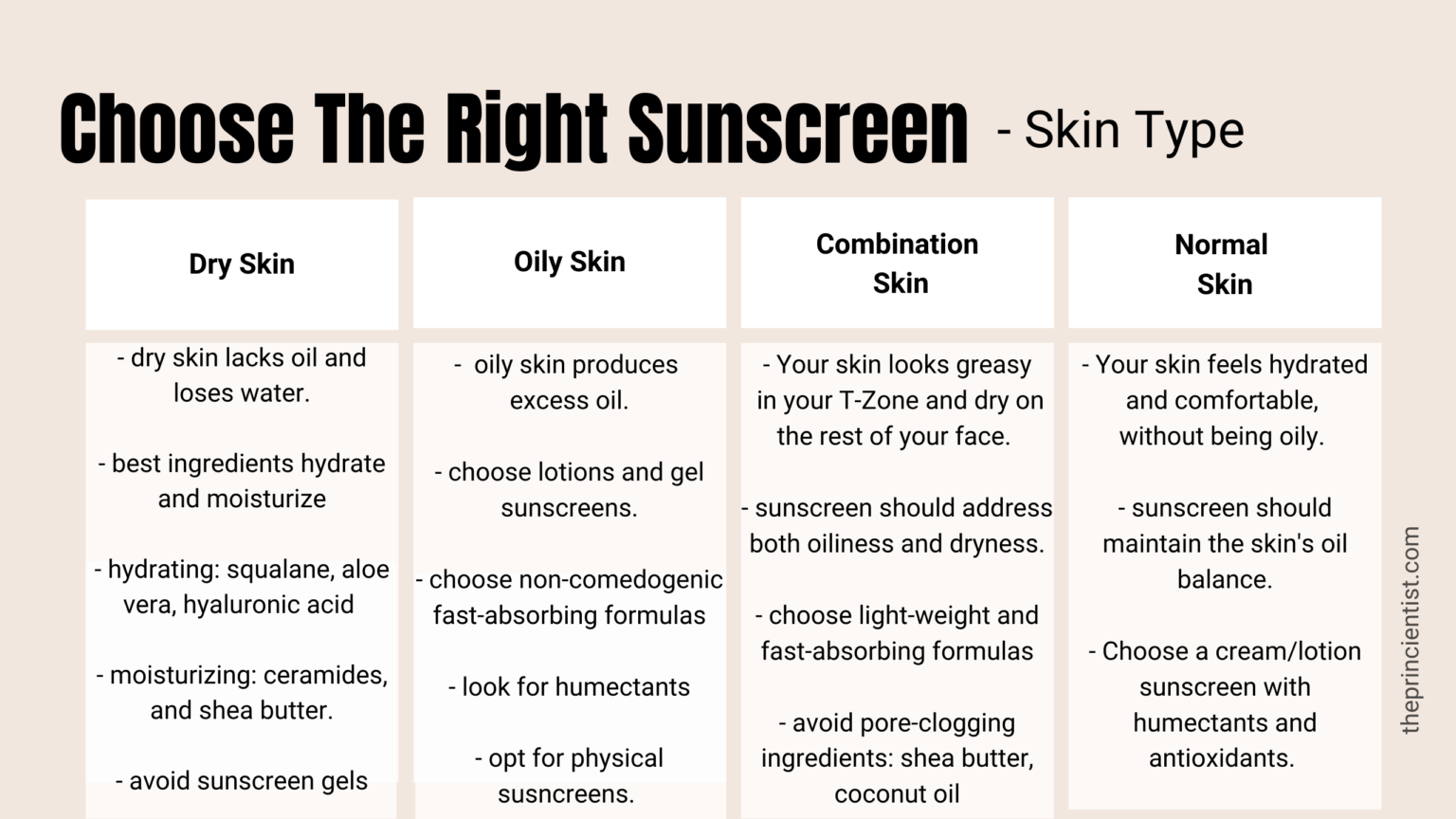
How to apply sunscreen?
Step-by-step instructions
Sunscreen is the last step of your morning skincare routine before applying makeup.
You don’t need sunscreen before bed because you will not be exposed to sunlight.
- Cleanse your face.
- Apply a toner (optional).
- Apply any treatment products – like serums or prescribed creams (only if needed).
- If you skip the toner and serum, make sure to always apply your face moisturizer on damp skin. The moisturizer will lock in the hydration to keep your skin plump and soft.
- If you apply a toner and a serum wait 1 minute for the serum to absorb into the skin and then apply a moisturizer.
- If you use any eye cream apply it first after the serum and before the moisturizer.
- For the eye cream apply a tiny amount onto your ring finger. Gently dab the cream under your eyes. Avoid pulling on the skin.
- Apply moisturizer (lotion, cream, or oil) to your skin massaging it gently in circular motions and upward strokes.
- Wait for the moisturizer to be absorbed into the skin.
- Choose a sunscreen that has an SPF of 30 or higher, is water resistant, and broad-spectrum.
- You don’t have to apply sunscreen immediately after the moisturizer. Wait and apply the sunscreen to dry skin 20–30 min before leaving the house. It takes approximately 15 minutes for your skin to absorb the sunscreen and protect you. If you wait until you are in the sun to apply sunscreen, your skin is unprotected and can burn.
- Apply sunscreen to all exposed skin. Follow the “two-finger” rule for your face and neck. Distribute sunscreen along the length of your pointer and middle fingers. This amount will ensure that your face and neck are protected. Apply a full shot glass worth of sunscreen to your body.
- For hard‐to‐reach areas like your back, ask someone to help you or use a spray sunscreen. To protect your lips, apply a lip balm with an SPF of at least 15
- Wait at least 5 minutes before you put on makeup.
- Reapply every 2 hours to ensure that your skin is thoroughly and effectively protected from the sun. Reapply immediately after any excess sweating, after washing your face or after any water activities.
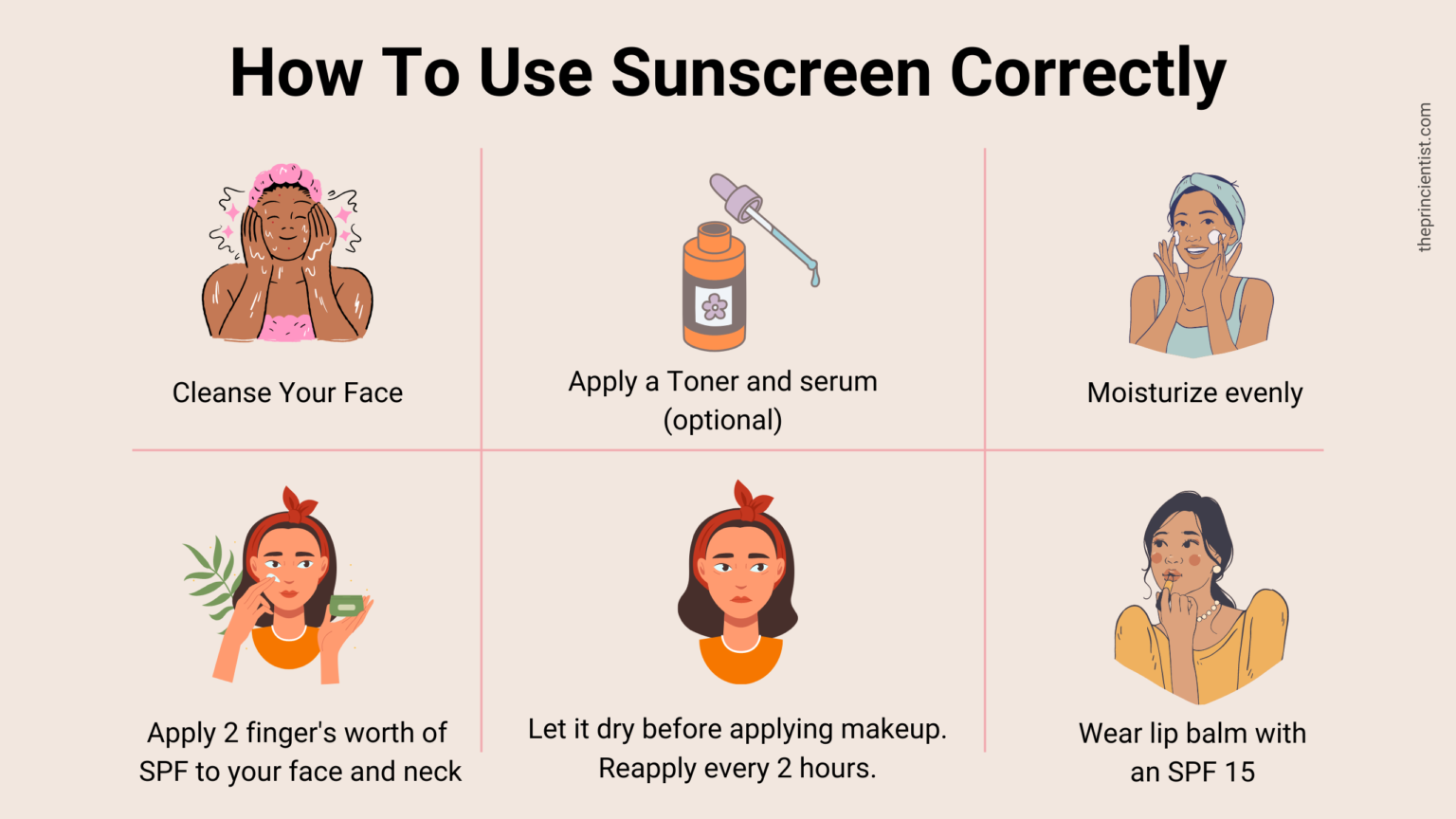
Note: Frequently forgotten spots: Ears, Nose, Lips, back of the neck, hands, tops of feet, along the hairline, bald or thinning areas of the head exposed, back of the knees.
Sunscreen in Your Skincare Routine
Sunscreen is a part of your routine whether you have a simple 3 step skincare routine or a more advanced skincare routine.
It is the last and most important step so make sure you never skip it.
Make adjustments according’s to your skin’s needs when the seasons change or if you travel to a new location.
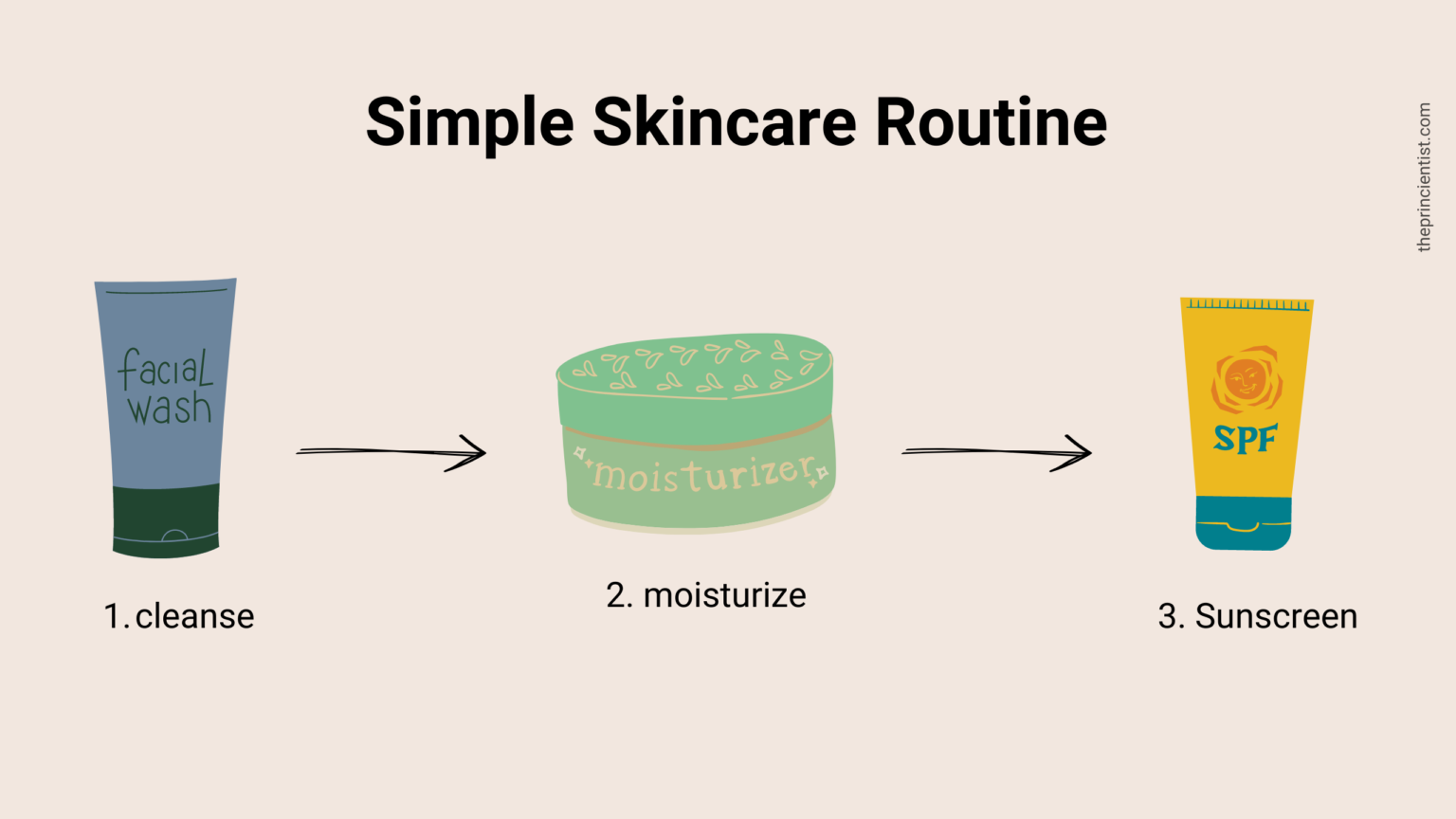
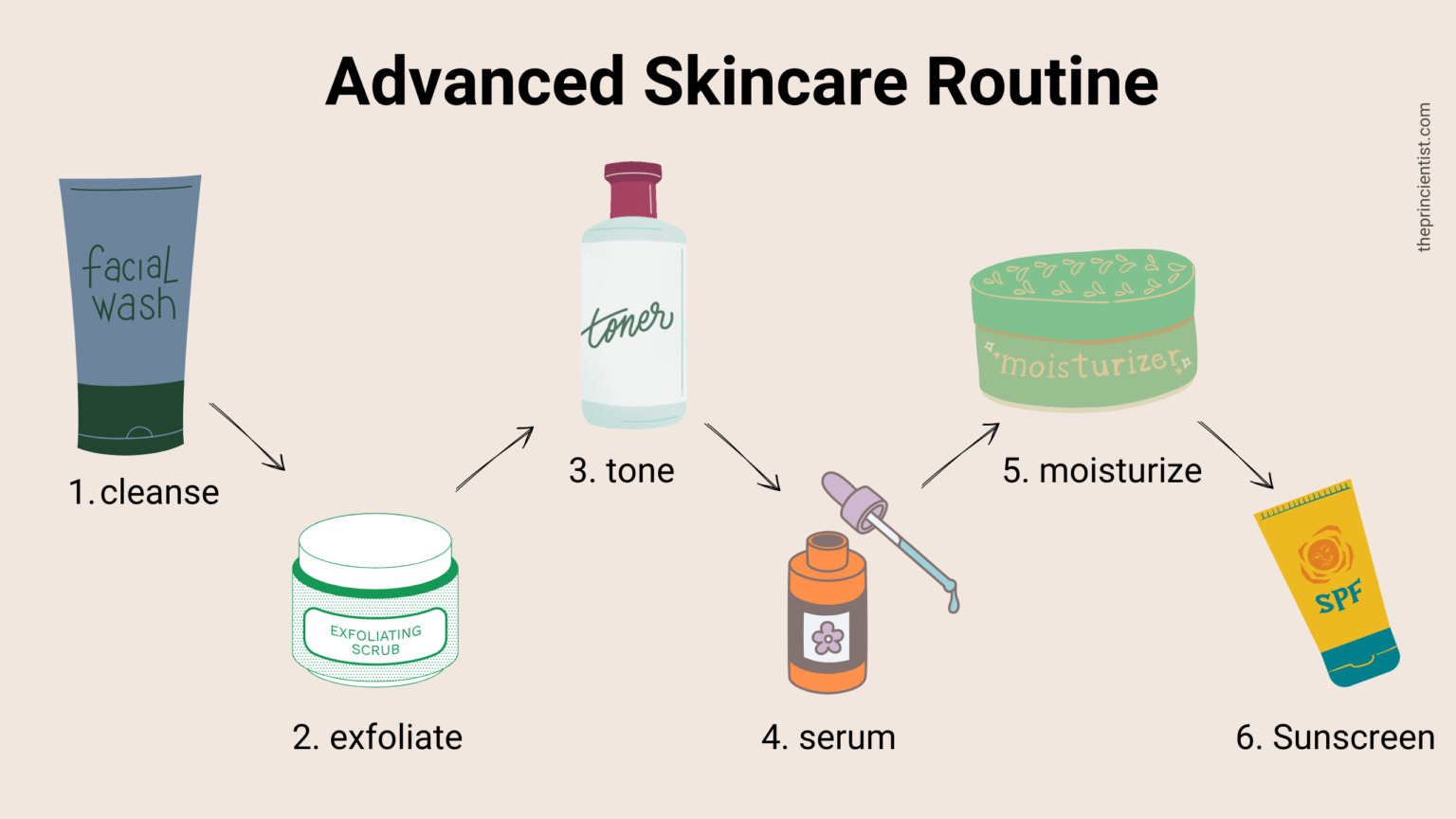
Now you know what is sunscreen, how it works and why it is important to use it daily.
Grab your current sunscreen and see the “how to choose a sunscreen” section to make sure you made the correct choice.
You need to check regularly if the skin products you are using suit you skin type and needs.
Using the correct products for your skin type in the right order is essential to guarantee your skin remains healthy, young and protected.
Coming soon I have the perfect post to help you build a skincare routine just for you.
In the meantime scroll to the end of the page to read the other articles of the series and choose the best products for your skin type.
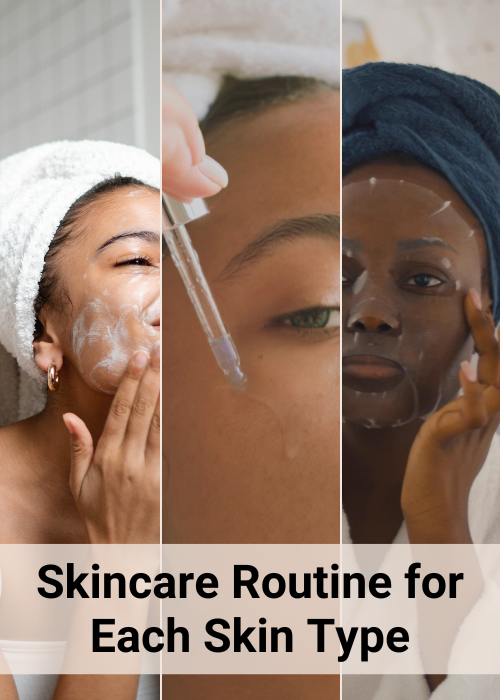
Guide To the best recommendations in creating a skincare routine for your skin type – oily, dry, normal and combination skin types.
Coming Soon →
Disclaimer: This article is informational only. This article does not provide medical advice, diagnosis, or treatment. Any information published on this website or by this brand is not intended as a substitute for medical advice, and you should not take any action before consulting with a healthcare professional. If you have questions or concerns about caring for your skin, you should make an appointment to see a board-certified dermatologist.
You Might Be Interested In
Skincare Products Made Easy – Article Series
What is an exfoliator. Differences between Chemical and physical exfoliators. How to choose an exfoliator for each skin type.
What toner do and why you need one. How to choose the right toner for your skin type.
